
Better known as C.J. Taylor, author/illustrator and fine artist Carrie-Jo Taylor was born on August 31, 1952 in Montreal, PQ. Carrie's transformation into C.J. had a very pragmatic basis. "When I first started painting, I found it very difficult to write with a paintbrush in order to sign the paintings. It was just a lot easier to put C.J. than Carrie-Jo." Using initials in lieu of given names had an interesting spinoff. "When I started exhibiting my work, people would look at the paintings and ask, 'Where's the gentleman that did them?'"
Books by C.J. Taylor.
Bones in the Basket: Native Stories of the Origin of People. Tundra Books, 1994. 0-88776-327-8 (cl), 0-88776-450-9 (pbk). Grades 2-8.
The Ghost and Lone Warrior: An Arapaho Legend. Tundra Books, 1991. 0-88776-263-8 (cl), 0-88776-308-1 (pbk). Grades 2-6.
How Two-Feather Was Saved From Loneliness: An Abenaki Legend. Tundra Books, 1990. 0-88776-254-9 (cl), 0-88776-282-4 (pbk). Grades 2-6.
How We Saw the World: Nine Native Stories of the Way Things Began. Tundra, 1993. 0-88776-302-2 (cl), 0-88776-373-1 (pbk). Grades 2-8.
Little Water and the Gift of the Animals: A Seneca Legend. Tundra Books, 1992. 0-88776-285-9 (cl). Grades 2-6.
The Messenger of Spring. Tundra Books, 1997. 0-88776-413-4. Grades 2-6.
The Monster From the Swamp: Native Legends of Monsters, Demons and Other Creatures. Tundra Books, 1995. 0-88776-361-8. Grades 2-8.
The Secret of the White Buffalo: An Ogla Legend. Tundra Books, 1993. 0-88776-321-9 (cl), 0-88776-399-5 (pbk). Grades 2-6.
This article is based on an interview held in Winnipeg on October 27, 1998.
 C. J. Taylor
C. J. Taylor
Profile by Dave Jenkinson.
Carrie candidly acknowledges that her childhood was not the best. "My father, being Mohawk and very visibly native, along with his being taken out of his culture, caused him to go through a lot in his life. One of 19 children, he not only suffered racism but poverty. He grew up to be a mean, cantankerous man, not the best qualities for fathering a child, but I have no animosity left. I understand what he'd gone through, and I settled it within myself. Bones in the Basket is dedicated to him. It has the Mohawk creation story, and, because my father never learned about his culture, I wanted to 'give' it to him."
"I was raised in a little place in the Eastern Townships, Glen Sutton, which consisted of a general store, a hotel, a few houses, a couple of churches and that was it. I went to school in Glen Sutton and Matsonville. My mother was a teacher, but my father figured that, because I was female, I didn't need an education, and so I was taken out of school at 16. I was also a very young mother, having my first child at 19. I was a single mom for a while. It's a hard job, but my kids were great, and they were the reason I kept going. We're close, and they're close with each other. It's one of the most important jobs we have because we prepare them for their lives, and, most of the time, single mothers aren't prepared for their own life, let alone preparing someone else for theirs." 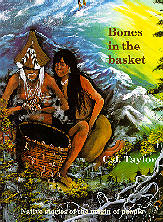
"As a child, I wanted to be a veterinarian, but women didn't do those jobs. I loved horses and wanted to be a jockey. Like I said, I got married early and had kids early so I've done many jobs, but none of them from my expectations as a child. I started painting at 16. My mother had an old set of oil paints, and I used all those up, but I never replaced them. I didn't start painting again until about 10 years ago. I don't know what brought me back to it other than desperation. I was raising three kids and working five part-time jobs around their school hours so I wouldn't have to leave them with babysitters. I just got tired of it all and started working on my art. I registered for an exhibit at Westmount Art Gallery and had a year to prepare. About two weeks before the exhibit, I ended up throwing everything out and went and got some paper and pencils and started doing portraits of the native leaders that I looked at as a child and found fascinating. That was my first exhibit, and after that the art just started coming out."
"I was about six when I discovered my culture. I remember being fascinated all the time by the old westerns on television. I would look at them and look at my father and see that there was some similarity there. I kept asking my mother, and she told me that my father was native. Meeting my grandmother for the first time was amazing. It was like looking at Geronimo. I remember the first time I saw her. Very old and blind, she was sitting in a rocking chair, rocking, with a shawl over her head and her prayer beads in her hand. Because my father would never allow me to cut my hair, I always had long braids. I remember my grandmother feeling for my hair and saying, 'Never cut your hair. Short hair is for sad people.' Then I watched her hair fall over her face, and it had all been cut."

"I started to ask a lot of questions about my native heritage of anyone who would answer them. When I first read Bury My Heart at Wounded Knee by Dee Brown, I was angry. I was angry because nobody had ever told me that this was my past and this was what the people had suffered. And, of course, 1990 and Oka was a big turnaround for me as I watched the effigy that was burned. I suddenly realized what my father had gone through, and it just clicked in my mind. The tears that rolled down my face that day were not mine but my father's, and I promised myself, my children and my father that I would make a difference. From that day forward, I've been doing books and touring and talking about it and learning and sharing. I write for one race - the human race so we can all live in harmony. If we keep fighting each other, we're only going to destroy our planet and have nothing left."
Carrie credits Tundra publisher May Cutler with being "one of the biggest influences in my life. I'd been painting for maybe two years when she contacted me. May believed in me long before I even knew there was a 'me'. She's a strong woman, and I learned a lot from her. And she kicked my butt when it needed to be kicked. Sometimes I'd get real lazy or feel inferior or not able to do it, and she'd just give me hell and get me doing it again. She was a good influence on me. I owe her a lot."
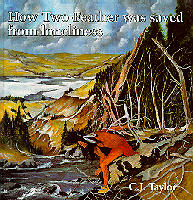
The result of Carrie's being approached by May Cutler has been a series of books containing single native legends, plus three collections of stories linked thematically. Most of Carrie's books have been translated into French and a number into Swedish and Danish. How Two Feathers Was Saved From Loneliness, Carrie's first book, she calls a "real learning experience, particularly in anatomy. When I look at it now, I go, 'Oh my god. Isn't that dreadful, and I won an award with it?' I still can't believe it. But the kids love it, and that's the main thing." Carrie says she didn't have any trouble in working with the picture book length. "Dividing the story up and finding the visuals for it came real easy for me. Trying to get my characters to look on canvas as they did in my mind was the challenge. It was just a matter of practice and working with my materials more. I think I'm catching on."
The stories in Carrie's books are not limited to just tales from the Mohawk tradition but are drawn from native peoples across the continent. Much of Carrie's research related to stories from other cultures is oral in nature. "As much as possible, I try to speak to people from the particular nation. With the Friendship Centre in Montreal, it's not difficult, and I do have a lot of friends in the native communities across Canada and the United States. In selecting a story, I try to look for one that, first of all, visually presents itself to me and also one that has a good moral to it, good lessons to be learned from it. You can read one of my stories three or four times, and each time you'll find another meaning." That Carrie does not speak any traditional language she does not see as an impediment to her gathering and telling the stories. "Language is from the brain, and I communicate from the heart in my paintings."
Another valuable feature of Carrie's books is her inclusion of factual information about the peoples from whom her stories are taken. Carrie authors these closing sections as well. "I include information about where the people are today because it's a far cry from where they were when these stories came from them. After reading Wounded Knee, I can understand the uprooting and the confusion of the people, and how they suffered with the physical and environmental change that they suffered with. It was difficult for them, but they survived." 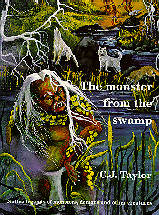
"Most of the stories I've found in print, but a lot of them are told by storytellers. I go to pow-wows and festivals, and I hear them. Some of them have been 'given' to me to do. The Monster From the Swamp has two stories, the title story and 'How Muddy Lake Got Its Name,' that were told to me by very special people, and, for me, it was a great privilege to do them. If a story has been printed and I hear a storyteller tell it, then I'll tell the storyteller that I'm planning on doing the story. I've never had a problem, and no one in the native community has ever come to me and told me that I have no right to do this. I feel that these stories give us valuable knowledge, and knowledge is for everyone."
Reader feedback has also provided impetus for Carrie's writing. "The idea for The Monster from the Swamp book came from kids' suggestions. I asked them what they wanted in the next collection, and they all wanted monsters. We have great monsters in our mythology, and so it was hard to figure out which ones to leave in and which ones to leave out."
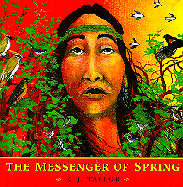
In her retellings, Carrie definitely puts her own stamp on the stories. Some must be pared down while others need expanding. "When I found The Messenger of Spring, it was only three or four lines, perhaps a paragraph at the most, but it impressed me. I saw many visuals from it. I had to break it down and make it a page story. Text and illustration come together for me. As I'm working on the paintings, the text is going through my mind. Sometimes I'll put things in the paintings that I'll take out of the text, or I'll put things into the text and take them out of the paintings. So they grow together."
Carrie admits, "I'm not computerized myself, and my text is all handwritten. When my 'computer's' down, I just sharpen it and get back to work." However, Carrie's reliance on a pencil does not mean that she's unaware of computers and their potential. "While I was in a school, I was watching a child work this one computer program. It impressed me with how it was going back and forth and giving so much information to the child. I tried to build that idea into the paintings as I was doing The Messenger of Spring. The birds, animals and insects are all accurate as are the changes as they progress through spring. For example, the caterpillar changes into a butterfly. I did all this just for the purpose that some day the book might be put on CD-ROM with offshoot information for the kids."
To date, the illustrations in Carrie's books have been rendered in acrylic on canvas. "I like acrylic because it dries fast. I don't have patience for oils. Two weeks later, and it's still wet! Acrylic dries quickly, and even then I use a hair dryer. You can work acrylic like oil, but, better, it has the transparency of watercolour. I do everything with it, including painting clothing, like jackets. You can throw them in the wash, and they come out just fine." Another of Carrie's "tools" is gesso. "It's a white paint with a lot of glue in it. You use it to prepare your canvas, particularly stretched canvas. If you don't use it on your stretched canvas, the paint will eventually crack. You can also use it like 'Whiteout'. I use a lot of it. When I first started working on my art and I started with acrylic, discovering gesso was wonderful. I could only afford one large canvas, and so I'd do a painting and then paint over it with gesso and begin again. I still have a canvas that weighs about 500 lbs and is about three feet thick."
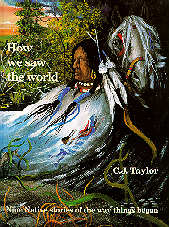
"Idiosyncratically" might be the word to describe how Carrie works on a book's illustrations. "I start in the middle; I start at the end; I start with whatever hits my fancy at the time. I've been known to work from the back page to the front and from the front to the back or start from the middle and go both ways. Sometimes I'll work on all of the illustrations at the same time. Without any interruptions and without leaving my studio, I could probably do a book in about two, three weeks. I try to do at least one book a year at least, but I'd like to do more."
As a fine artist, Carrie produces some 250-300 paintings a year. According to Carrie, there's a simple explanation for her prolific output. "I work very quickly, and I work long hours. To me, it's not work. It's an obsession, a drive, and I can do a 2' X 3' painting or one 4' X 3' in two to three days. I usually have three or four paintings going at once, often different subjects, from the sublime to the ridiculous. While one's drying, I go and work on the other one. I also use a hair dryer to speed up the drying. I don't use oil any more. Presently I'm using mixed medium. Since I've never studied art formally, I don't have a professor's voice in my head saying, 'You can't use that for that.' I just do it. Because my husband does drywall, there's always lots of plaster around, and I started sculpting with it. I use the material that they use on casts, the gauze with the plaster, anything that I can get my hands on that suits the purpose. I first have my concept, and then I look for the material that suits it." 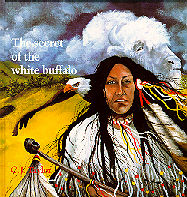
In creating her paintings, Carrie usually works from her imagination, but if it's something like "The Story of Hiawatha," a book she's presently illustrating, then she uses live models. "Most of Kahnawake's council have been my models. Another novel I'm working on now, Singing Wolf, also involved models. It's a story from Pierre Radisson when he was captured by the Mohawks and then adopted. I'm writing it from the viewpoint of the young boy who adopted him as a brother, a 16-year-old Mohawk boy in the 1600's. I'm using my son Joey as the model for Pierre Radisson. This is my first novel, and I think it's for young adults to adults."
When asked to explain why she chooses to work on large canvases, Carrie smilingly responds, "To compensate for my own lack of size? I just like working on big canvases, the bigger the better. Some day I'm going to have an entire wall to do. I would love to do a teepee. For me, that would be one gigantic canvas. My studio is getting smaller because my pieces are getting bigger. With some of the installation pieces I work on, I have to figure out how to do them in sections so I can get them out of my studio without taking a wall down."
Long hours also contribute to Carrie's productivity. "I get up religiously every morning at 6:30. My cat has a lot to do with that, and, after I kick my husband out of bed to feed the cat, then I get up. By the time I reach consciousness around seven, I'm in my studio working, and I just keep going. Sometimes I'll go 18-20 hours and not even think about food. Luckily my husband cooks and does housework too. He has to. I'm lucky. He's a 'keeper.' I'm always ahead of deadlines because I do work so quickly so there's never a problem there."
Part of Carrie's work pattern also includes painting to music. "Sometimes I'll put music on, and it will impress me enough to get up and do a painting, but sometimes I'll be working on a painting and need a type of music. When I do portraits, for instance, I'll play different types of music to suit the characters that I want to portray. I have a big music collection. Music's our passion at home. We have everything, but mostly blues, from the old-timers to the new stuff. I have a boombox bigger than my kids'."
"I do a lot of other artistic endeavors. Every little bit helps, but I never step outside the arts though and haven't for 10 years. I've worked within the arts in one way or another. I had a radio show for four years, and I've done an animation for CBC-TV. We worked on three called 'Legends of the Land." Mine was a Mohawk story I wrote, and I did the casting for the voices and for the music. I helped put it into scripts and did a bit of the directing and one of the voices. I had a great time."
Given Carrie's work habits, naturally she has many book projects underway and at the planning stage. A book Carrie is illustrating is 'The Story of Hiawatha' which is being written by an elder, Ronwaniente Jocks. "He's the same man who gave me 'The Monster from the Swamp.' We worked on a movie script a few years ago, and we did a radio program, 'Earth Songs,' for four years so we work well together. He's taught me a lot. This story is such an important part of our history and to have it accurately presented is important because, down through history, it's always been written by someone outside of our culture. We wanted to write it from our point of view. Ronwaniente's also done a great deal of research on the story. We've tracked it back through time as accurately as we can. Obviously it happened before the arrival of the Europeans and the Confederation, but we can trace it back to an eclipse because the story, itself, tells of an eclipse during this time. We can trace the eclipse back to the 1840's. It's a story that takes place during a time where magic made more sense than science. So it's wonderful story. It's to be a picture book."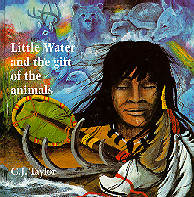
"Fragments of Thought" is a prose and poetry collection Carrie has been assembling for over a decade. "I haven't even approached a publisher yet on it. I'm just collecting these pieces. They come to me, and I do them. In conjunction with some art exhibits, I recite the poetry. The poems are being put to music as well which is difficult because I can't sing. Actually, people pay me not to sing. I hear the music in my head, and so I'm working with a really good musician who's helping me to bring it out. While it's definitely an adult book, I do the poetry with teenagers. What really impresses the teenagers when I'm doing it locally is that I can bring the paintings with me. They're very large, and some of them are done under black light which a lot of the kids haven't seen. I do the main painting first in daylight, and then, at night, I work under black light. I work with a fluorescent paint that they use for silk-screening. I apply it to the paintings, and it makes them glow under the black light. I missed the Sixties entirely so I'm making up for it."
Trickster tales have yet to make their way into Carrie's books, but they could be there in the future. "There's a lot of tricksters. I have quite a collection, and I'm thinking about putting them into a book. There's a few that I love, like Coyote, and there's a character that's not meant for children. He's always getting in trouble with the ladies, him and Coyote. I'd love to do a collection of them."
Naturally, the contents of Carrie's books entertain their young readers/listeners, but she has more profound hopes for their effects on her audience. "I want my books to enlighten people, make them think. I want them to have a respect for the Native people, and I think that's something that's been lacking since 1492. I think that 'we've' got a bad rap down through history. We've been portrayed as being without religion, without spirituality, that we were stupid and without a sense of humour. We have a wonderful sense of humour. It's very simple humour. There's nothing complex about it. It's just good down home laughter."
"Dreams and visions play a real role in what I create, and they don't only come to me in my sleep. Sometimes I'll be standing in front of a class and have a flash of something that comes into my mind. Sometimes it's so powerful that it'll come back again and again until I put it down on canvas. As a child, I used to have all of these thoughts coming into my mind, and everyone, particularly my father, would say, 'Don't tell anybody. They'll think you're crazy.' But as I get older, and I guess it's my change of life too that has opened up that part of my mind, my spirit, that allows it to come, so it's very natural to me now. I don't dismiss it. I pay attention to it a lot more. It's kind of like an instinct, a vision, I guess I just it's something that's me and makes me an artist."
Surprisingly, it is Carrie's children's books, and not her fine art, which yields her principal source of income. "The books support me to do what I really want to do, which is the 'crazy' paintings. I don't sell a lot of art in Quebec because the people there aren't fascinated with Indian art. I sell some of the paintings from my books but not a great deal. Because my kids are all grown up and I don't have a lot of wants and needs, I don't need a great deal of money. I have a beautiful house with a studio, and, as long as I have money for canvas and paint and my bills are paid, I'm happy."
"I'm doing what I'm meant to do. If I look back now, I'll have 20-20 hindsight, but I look at it, and this is a definite road that was planned for me. I take it very seriously too. I'm never going to stop. I don't have to retire. Because I can only get better and keep going and growing, retirement is not even in my realm of possibility. I thought about going to Concordia University and taking the fine arts program, but then I thought about it again. I thought about someone half my age telling me what I was doing was wrong. Most artists are very egotistical, and I don't think that would go over well. I'd hate to have to ground my teacher."
